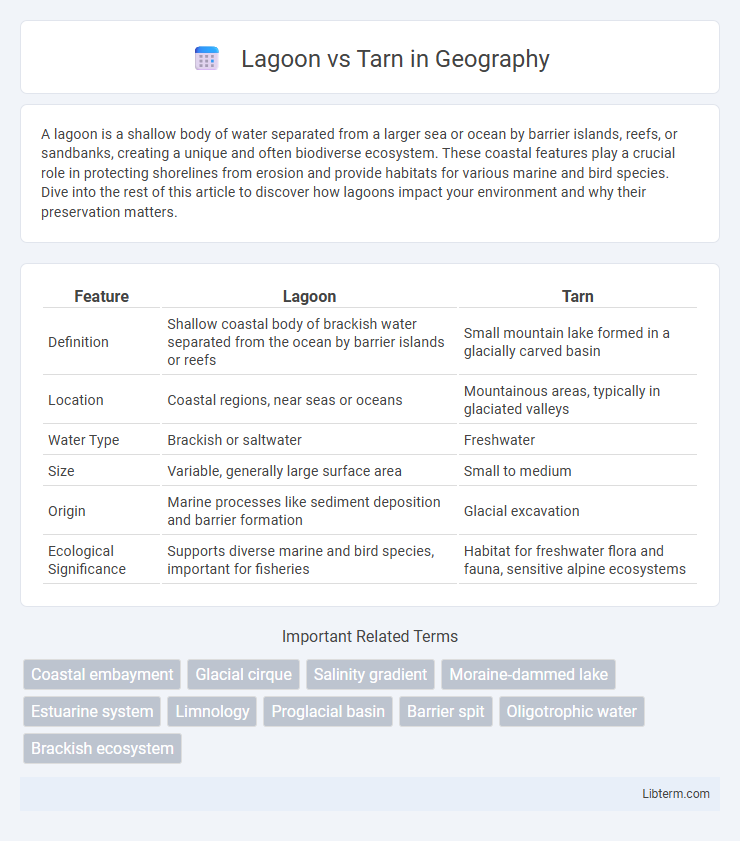A lagoon is a shallow body of water separated from a larger sea or ocean by barrier islands, reefs, or sandbanks, creating a unique and often biodiverse ecosystem. These coastal features play a crucial role in protecting shorelines from erosion and provide habitats for various marine and bird species. Dive into the rest of this article to discover how lagoons impact your environment and why their preservation matters.
Table of Comparison
| Feature | Lagoon | Tarn |
|---|---|---|
| Definition | Shallow coastal body of brackish water separated from the ocean by barrier islands or reefs | Small mountain lake formed in a glacially carved basin |
| Location | Coastal regions, near seas or oceans | Mountainous areas, typically in glaciated valleys |
| Water Type | Brackish or saltwater | Freshwater |
| Size | Variable, generally large surface area | Small to medium |
| Origin | Marine processes like sediment deposition and barrier formation | Glacial excavation |
| Ecological Significance | Supports diverse marine and bird species, important for fisheries | Habitat for freshwater flora and fauna, sensitive alpine ecosystems |
Introduction to Lagoons and Tarns
Lagoons are shallow coastal water bodies separated from larger bodies of water by a barrier such as a sandbar or coral reef, often characterized by brackish water and abundant marine life. Tarns are small mountain lakes formed in glacially carved cirques, typically found in high-altitude alpine regions with clear, cold freshwater. Both geological features serve distinct ecological roles, with lagoons supporting diverse coastal ecosystems and tarns reflecting glacial geological history.
Geological Formation of Lagoons
Lagoons form through coastal processes where barriers like sandbars or coral reefs enclose shallow bodies of water, often resulting from sediment deposition and wave action along shorelines. Their geological formation involves the gradual accumulation of sediments creating a separation from the open sea, fostering unique ecosystems. In contrast, tarns are mountain lakes formed by glacial erosion and meltwater filling depressions carved into bedrock, emphasizing different geological origins.
Geological Origin of Tarns
Tarns are small mountain lakes formed in glacially-carved cirques, created by the erosive action of glaciers over bedrock in alpine regions. Unlike lagoons, which are typically coastal water bodies separated from the ocean by barrier islands or reefs, tarns originate from glacial processes and are often found in high-altitude valleys. Their geological origin involves glacial excavation and subsequent melting that fills these depressions with water, distinguishing their formation from the sedimentary processes shaping lagoons.
Key Differences Between Lagoons and Tarns
Lagoons are shallow bodies of water separated from larger seas by barrier islands or reefs, typically found in coastal regions, whereas tarns are small mountain lakes formed in glacial cirques at high elevations. Lagoons often exhibit brackish water due to mixing of saltwater and freshwater, while tarns contain purely freshwater from snowmelt or rainfall. The ecological environments also differ: lagoons support diverse marine life and are influenced by tides, whereas tarns have unique alpine ecosystems with limited species adapted to colder temperatures.
Ecological Importance of Lagoons
Lagoons serve as vital ecological habitats supporting diverse species of fish, birds, and invertebrates due to their nutrient-rich, brackish waters, contrasting with the often oligotrophic nature of tarns. These coastal or inland water bodies act as natural filters, improving water quality and providing nursery grounds essential for marine biodiversity. Lagoons also contribute to shoreline protection by buffering storm surges and preventing erosion, highlighting their critical role in maintaining ecological balance and supporting ecosystem services.
Biodiversity in Tarns
Tarns, formed in glacial cirques, exhibit unique biodiversity due to their cold, nutrient-poor environments that support specialized cold-adapted aquatic species and endemic flora. Unlike lagoons, which are often brackish and influenced by marine conditions, tarns sustain oligotrophic ecosystems characterized by low productivity but high ecological significance for sensitive species such as alpine algae, crustaceans, and certain amphibians. The distinct abiotic factors in tarns create isolated habitats that contribute to biodiversity hotspots, emphasizing their conservation importance in alpine and glacial regions.
Human Interaction and Accessibility
Lagoons often provide easier human interaction opportunities due to their shallow waters and proximity to coastal communities, making activities like fishing, boating, and swimming more accessible. Tarns, typically found in mountainous or remote areas, present limited accessibility, requiring hiking or specialized equipment, which restricts frequent human engagement. The accessibility of lagoons fosters greater recreational use and local economic benefits, whereas tarns remain primarily valued for their natural preservation and low-impact visitation.
Popular Lagoon Destinations
Popular lagoon destinations such as the Maldives, Bora Bora, and the Great Barrier Reef are renowned for their crystal-clear waters, abundant marine life, and vibrant coral reefs. These lagoons provide ideal conditions for snorkeling, diving, and luxury resorts that cater to eco-tourists and honeymooners alike. Unlike tarns, which are mountain glacial lakes often found in alpine regions, lagoons are typically coastal, offering warmer waters and rich biodiversity.
Famous Tarns Around the World
Famous tarns around the world, such as the iconic Grasmere Tarn in England's Lake District and the stunning Blausee in Switzerland, offer pristine glacial waters nestled within mountain valleys. Unlike lagoons, which are coastal bodies of shallow salt or brackish water separated from the ocean by barrier islands or reefs, tarns are typically small mountain lakes formed in cirques carved by glaciers. These high-altitude tarns, often found in alpine regions, provide unique ecological habitats and attract hikers and nature enthusiasts with their crystal-clear waters and dramatic surroundings.
Conclusion: Choosing Between Lagoon and Tarn
Choosing between a lagoon and a tarn depends largely on the specific environmental context and desired ecological outcomes. Lagoons, characterized by shallow, brackish waters often influenced by tidal flows, support diverse marine and bird life, while tarns, typically small mountain lakes formed by glacial activity, provide unique cold-water habitats supporting specialized flora and fauna. Decision-making should consider factors like water salinity, biodiversity value, and geographical setting to optimize conservation and usage strategies effectively.
Lagoon Infographic

 libterm.com
libterm.com